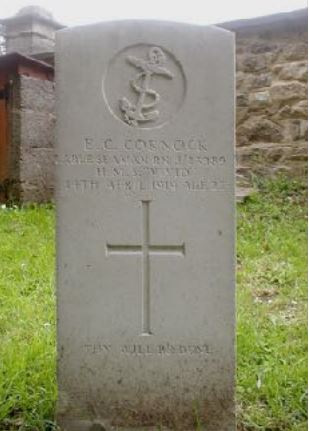Royal Navy – HMS Vivid

Ernest Charles Cornock was the eldest son of Charles and Millicent Cornock of Valley Road, Wotton-under-Edge. Ernest was born on 16 June 1896.
As a young man Ernest joined the Scouting Movement, one of the first Wotton boys so to do. He was also a chorister at St Mary’s Church, Wotton. Prior to joining the navy he was a rubber winder.
He joined the Royal Navy on 8 April 1913 as a Boy entrant and on 24 January 1914 joined the crew of the battlecruiser HMS Lion. On 16 June 1914 he signed on for a twelve year term as an Ordinary Seaman, still serving with the Lion. He was promoted to Able Seaman on 9 September 1915. He saw service right through the Great War, serving on (besides Lion) HMS Woolwich (from 22 May 1916), HMS Hecla (from 1 September 1917), HMS Blenheim (1 October 1917) and was with HMS Egmont (?) from 1 January 1919 until he was invalided out of the service on 19 February 1919. A report suggests he also served with the Acheron Class Destroyer, HMS Lizard. HMS Vivid was the RN’s ‘personnel establishment’.
His discharge from the Navy was due his suffering from a throat malady. He was taken to Cashes Green Sanatorium, Stroud but he did not recover from his illness, dying from pneumonia on 14 April 1919, aged 22. His body was brought back to Wotton and he was buried in St Mary’s Churchyard on Saturday 19 April. According to the Gazette report of the funeral, in its 29 April edition, it was an impressive event. The report stated that a large number of people attended, the coffin being shrouded with the Union flag. Six naval men acted as bearers – H Carter, W Dixon, W Knight, S Peglar, D Portlock and W Wheeler. The Rev F C Black officiated.
This must have been a very sad day, not only for Ernest’s parents, but also for his grandparents, who had lost three sons in the war and now their 23 year old grandson was also dead. No other family in Wotton could have been hit quite so badly in so short a time. There is a photograph of Ernest in the Bristol Times & Mirror of 1 April 1916.

Researched by Graham Adams (from original research by Bill Griffiths) 15 January 2012
